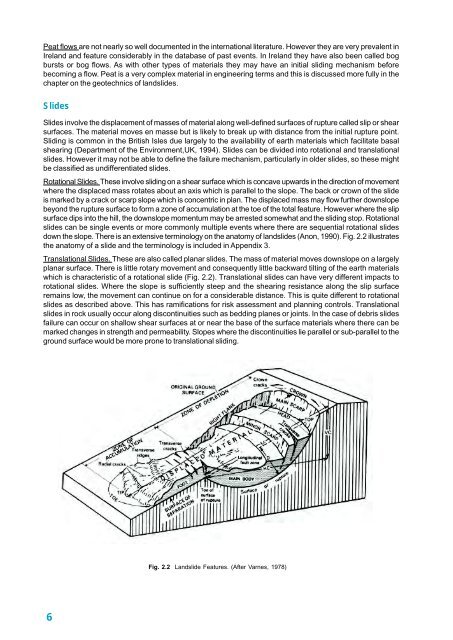to download report - Geological Survey of Ireland
to download report - Geological Survey of Ireland
to download report - Geological Survey of Ireland
- No tags were found...
You also want an ePaper? Increase the reach of your titles
YUMPU automatically turns print PDFs into web optimized ePapers that Google loves.
Peat flows are not nearly so well documented in the international literature. However they are very prevalent in<strong>Ireland</strong> and feature considerably in the database <strong>of</strong> past events. In <strong>Ireland</strong> they have also been called bogbursts or bog flows. As with other types <strong>of</strong> materials they may have an initial sliding mechanism beforebecoming a flow. Peat is a very complex material in engineering terms and this is discussed more fully in thechapter on the geotechnics <strong>of</strong> landslides.SlidesSlides involve the displacement <strong>of</strong> masses <strong>of</strong> material along well-defined surfaces <strong>of</strong> rupture called slip or shearsurfaces. The material moves en masse but is likely <strong>to</strong> break up with distance from the initial rupture point.Sliding is common in the British Isles due largely <strong>to</strong> the availability <strong>of</strong> earth materials which facilitate basalshearing (Department <strong>of</strong> the Environment,UK, 1994). Slides can be divided in<strong>to</strong> rotational and translationalslides. However it may not be able <strong>to</strong> define the failure mechanism, particularly in older slides, so these mightbe classified as undifferentiated slides.Rotational Slides. These involve sliding on a shear surface which is concave upwards in the direction <strong>of</strong> movementwhere the displaced mass rotates about an axis which is parallel <strong>to</strong> the slope. The back or crown <strong>of</strong> the slideis marked by a crack or scarp slope which is concentric in plan. The displaced mass may flow further downslopebeyond the rupture surface <strong>to</strong> form a zone <strong>of</strong> accumulation at the <strong>to</strong>e <strong>of</strong> the <strong>to</strong>tal feature. However where the slipsurface dips in<strong>to</strong> the hill, the downslope momentum may be arrested somewhat and the sliding s<strong>to</strong>p. Rotationalslides can be single events or more commonly multiple events where there are sequential rotational slidesdown the slope. There is an extensive terminology on the ana<strong>to</strong>my <strong>of</strong> landslides (Anon, 1990). Fig. 2.2 illustratesthe ana<strong>to</strong>my <strong>of</strong> a slide and the terminology is included in Appendix 3.Translational Slides. These are also called planar slides. The mass <strong>of</strong> material moves downslope on a largelyplanar surface. There is little rotary movement and consequently little backward tilting <strong>of</strong> the earth materialswhich is characteristic <strong>of</strong> a rotational slide (Fig. 2.2). Translational slides can have very different impacts <strong>to</strong>rotational slides. Where the slope is sufficiently steep and the shearing resistance along the slip surfaceremains low, the movement can continue on for a considerable distance. This is quite different <strong>to</strong> rotationalslides as described above. This has ramifications for risk assessment and planning controls. Translationalslides in rock usually occur along discontinuities such as bedding planes or joints. In the case <strong>of</strong> debris slidesfailure can occur on shallow shear surfaces at or near the base <strong>of</strong> the surface materials where there can bemarked changes in strength and permeability. Slopes where the discontinuities lie parallel or sub-parallel <strong>to</strong> theground surface would be more prone <strong>to</strong> translational sliding.Fig. 2.2 Landslide Features. (After Varnes, 1978)6
















